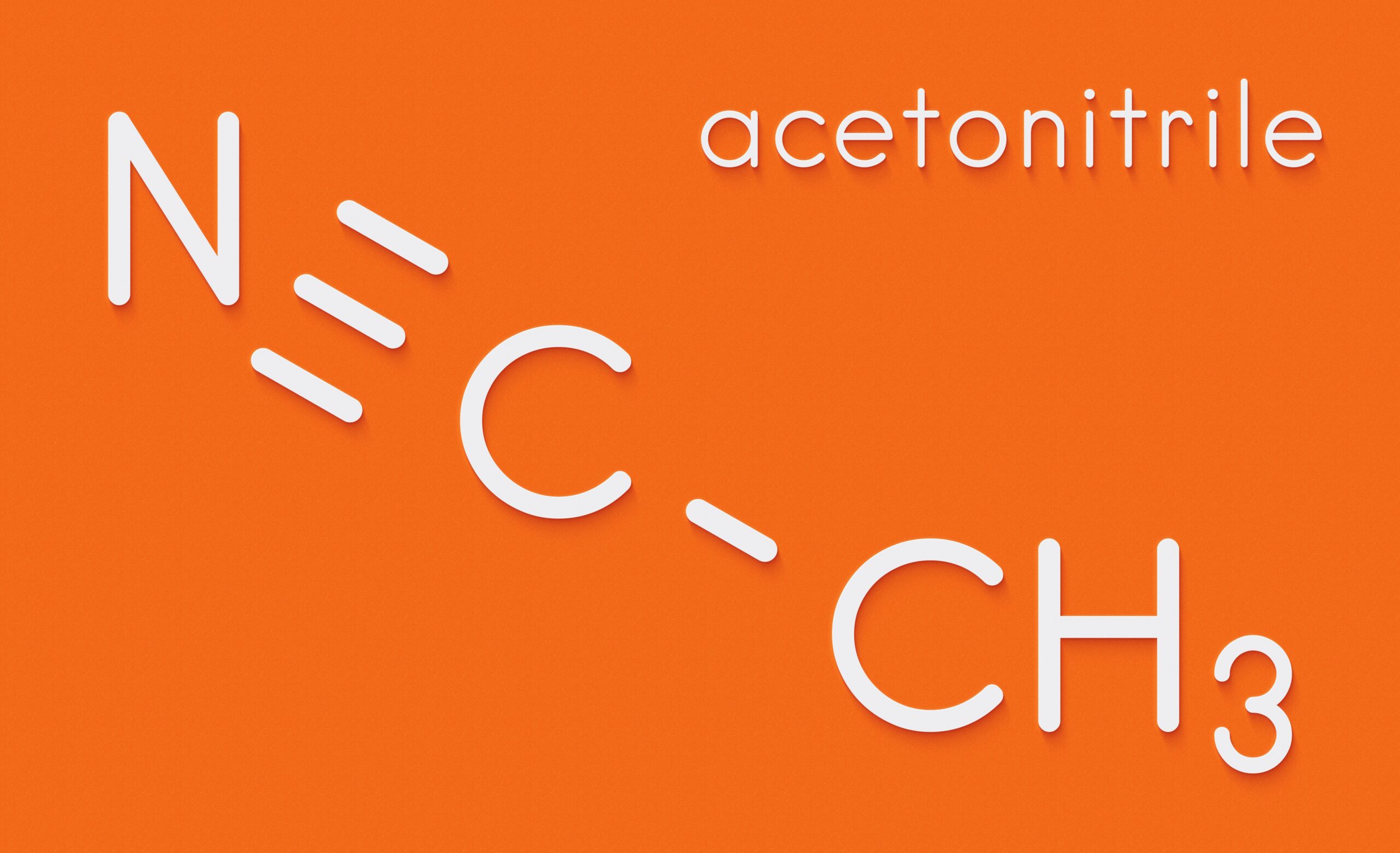INTRODUCTION
Acetonitrile (ACN) is a highly polar, volatile, colorless liquid with ethereal odor and is the simplest organic nitrile widely used as a solvent.
The nitrile group constitutes active part of the molecule. It participates in various reactions that lead to number of nitrogen containing organic molecules.
Manufacture
ACN is manufactured on large scale by addition of ammonia in propylene, acrylonitrile being the by-product.
| Synonyms | Methyl Cyanide Cyanomethane |
| CAS no. | 75-05-8 |
| EINECS no. | 200-835-2 |
| Molecular formula | C2H3N |
| Molecular weight | 41.05 |
| Structure |  |
Industrial Applications
ACN has excellent solubilizing properties. These enable its use as a useful solvent in synthesis and purification processes of distillation and recrystallization.
Commonly occurring uses as solvent are in:
| High pressure liquid chromatographic (HPLC) analysis as an eluent. |
| Butadiene extraction in Petro refineries. |
| Manufacture of insulin, vitamins, amino acids and photographic films. |
| Lithium batteries. |
| Non-aqueous reactions that employ AlCl3 and PCl3. |
| Manufacture of flame retardants. |
| Extraction of fatty acids from vegetable oil. |
| Chemical intermediate and solvent for perfumes. |
| Catalyst and component of transition-metal complex catalysts. |
| Solvent for DNA synthesis and Peptide sequencing. |
| Solvent for spinning synthetic fibers. |
| Casting and moulding plastics. |
Intermediates
The nitrile group being reactive, ACN acts as a key raw material in production of:
| Acetamidine hydrochloride |
| Acetoguanamine |
| β-Aminocrotononitrile |
| 2,4-Dihydroxy acetophenone |
| 2,6-Dihydroxy acetophenone |
| Geranonitrile |
| Malononitrile |
| Triethyl orthoacetate |
| Sulphapyrimidines |
| O,N-bis(trimethylsilyl)acetamide |
Applications in APIs
As a key raw material in the early manufacturing stages of:
| Sulfisomidine | Antibacterial |
| Pyritinol | Nootropic |
| Cromolyn | Antiasthma / Antiallergic |
| Alprazolam | Anxiolytic |
| Diazoxide | Antihypertensive / Hyperglycemia |
| Triazolam | Hypnotic |
As an essential raw material in the ultimate synthesis step of:
| Amantadine | Antiviral / Antiparkinsonian |
| Sulphaphenazole | Antibacterial |
Agrochemicals
| Isoxaben | Herbicide |
SPECIFICATIONS
| Test | Unit | Specification |
|---|---|---|
| Appearance | – | Clear colorless liquid, free from extraneous matter. |
| Identification (By GC) | – | Retention time of the main peak in the test sample chromatogram should match with that of the standard. |
| Purity (By GC) | % | Min 99.0 |
| Moisture Content (By KF) | % | Max 0.2 |
| Miscibility | – | Miscible with methanol. |
| Non-volatile matter | % | Max 0.1 |
REACH status
Acetonitrile offered by ExSyn is registered under EU REACH regulations.
STORAGE
Product is stored at ambient temperature.
PACKING
Drum & ISO-tank
ExSyn offers acetonitrile on commercial scale and welcomes enquiries. No matter the quantity you need, our exceptional quality and service will make ExSyn your supplier of choice! If you need any additional information or SDS, please get in touch with us.
Iodine is anon-metallic, dark-grey/purple-black, lustrous, solid element. It is the heaviest and the rarest of stable halogens that can be found on the crust of earth.About fifty percent of all iodine produced and manufactured worldwide is used to form Organoiodine compounds. Iodine is an important element for many health-sustaining processes and essential for human thyroid health.
The product, acronymed Oct-NBE, is an organic compound with a cyclic ring system and a 8-membered hydrophobic chain. The structure renders the chemical special properties leading to its applications in diverse fields.
Nicotine is a hygroscopic, colorless to slight yellow, oily liquid, that is readily soluble in alcohol, ether or light petroleum. It is widely used recreationally as a stimulant and anxiolytic.
The product, acronymed ETD, is an organic compound with a fused bicyclic ring system and an ethylidene group. The structure renders the chemical special properties leading to its applications in diverse fields.
Sodium perchlorate monohydrate is the inorganic compound with the chemical formula NaClO4•H2O. It is the common existence form of sodium perchlorate, which can gradually absorb water in the air to form the monohydrate. Sodium perchlorate monohydrate is white rhombic crystal which is highly soluble in water and in alcohol. Its capacity to undergo redox reactions, liberating oxygen atoms, has been harnessed in the preparation of specialty chemicals, including pharmaceutical intermediates and fine chemicals.
Triphenylphosphine is a common organophosphorus compound that is frequently abbreviated as PPh3 or Ph3P. It is widely used in organic and organometallic compound synthesis because it is an effective reducing agent as well as a neutral ligand. At room temperature, PPh3 crystals are relatively air-stable and colourless.
Potassium chlorate holds significant importance across various industries due to its diverse applications. This white crystalline compound has been utilized for centuries as an essential ingredient in the production of matches, fireworks, and explosives, owing to its ability to release oxygen upon decomposition.
Podophyllotoxin is a non-alkaloid toxin lignan extracted from the roots and rhizomes of Podophyllum species. It is an organic heterotetracyclic compound that has a Furonaphthodioxole skeleton bearing a 3,4,5-trimethoxyphenyl substituent.
Octadecylphosphonic acid (ODPA), a versatile chemical compound, serves as a surfactant and dispersant in applications spanning coatings, lubricants, and corrosion inhibition. With its hydrophobic octadecyl chain linked to a phosphonic acid group, it excels in surface modification, boosting adhesion in metal surfaces.
